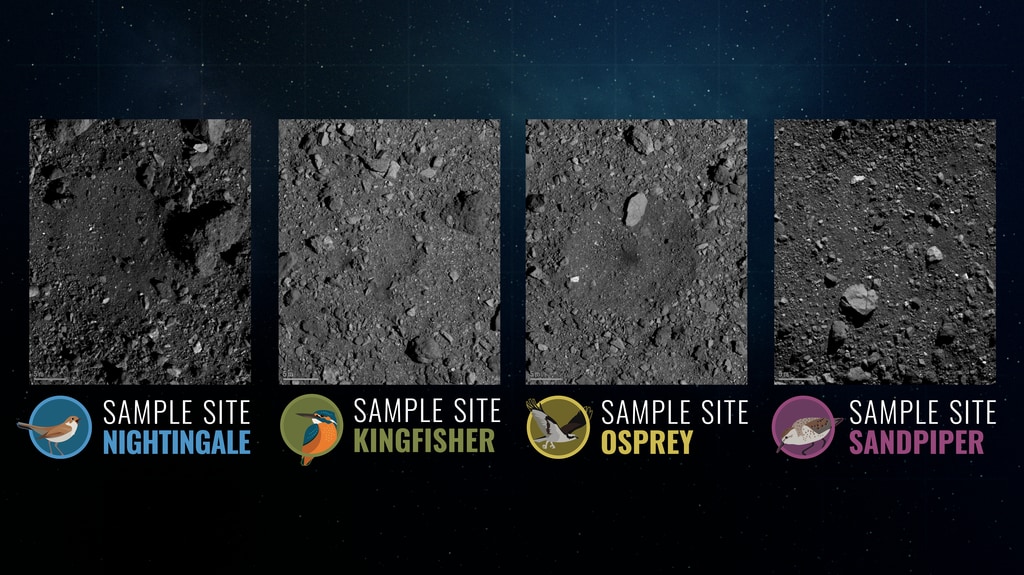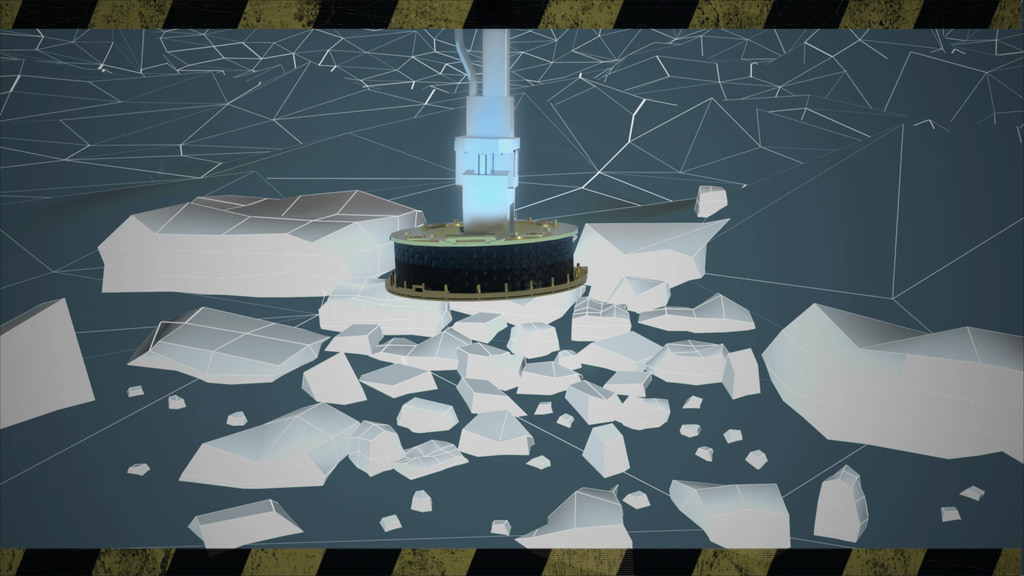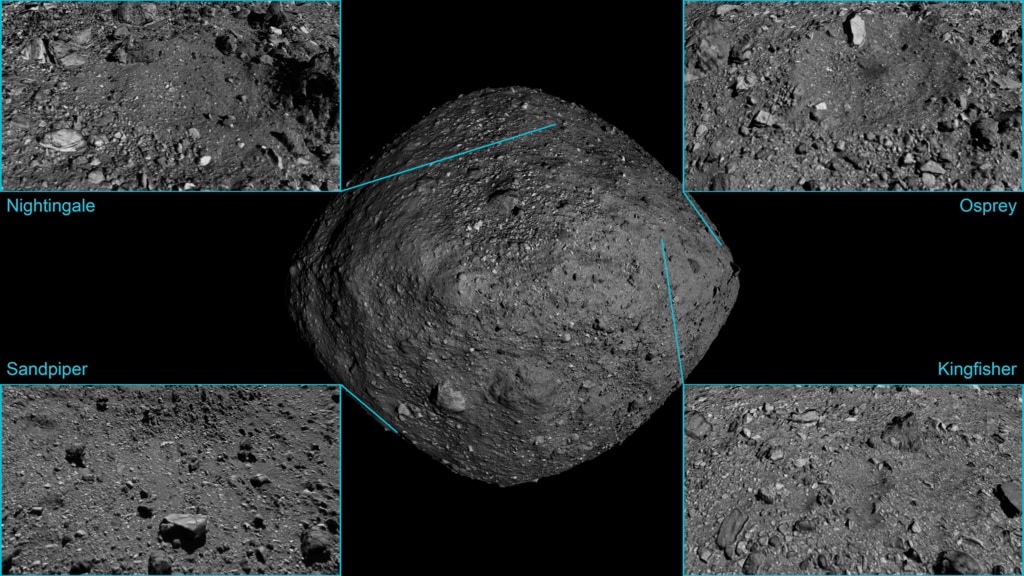OSIRIS-REx: Countdown to TAG
Trailer for the OSIRIS-REx TAG Event
Universal Production Music: "The Glory of Victory" by Frederik Wiedmann
Credit: NASA/Goddard
Download recorded audio from this media teleconference. (Right-click and select "Save Link As...").
NASA is hosting a media teleconference at 3 p.m. EDT Thursday, Sept. 24, to provide an update on the agency’s first attempt to contact the surface of asteroid Bennu and collect a sample next month.
The Origins, Spectral Interpretation, Resource Identification, Security-Regolith Explorer (OSIRIS-REx) spacecraft will travel to the asteroid’s surface during its first sample collection attempt Oct. 20. Its sampling mechanism will touch Bennu’s surface for several seconds, fire a charge of pressurized nitrogen to disturb the surface, and collect a sample before the spacecraft backs away.
Participating in this mission update are:
• Thomas Zurbuchen, associate administrator of NASA’s Science Mission Directorate
• Lori Glaze, director of NASA's Planetary Science Division
• Dante Lauretta, OSIRIS-REx principal investigator at the University of Arizona, Tucson
• Mike Moreau, OSIRIS-REx deputy project manager at NASA’s Goddard Space Flight Center
• Sandra Freund, OSIRIS-REx mission operations manager at Lockheed Martin Space
For more information, go to nasa.gov/osiris-rex or asteroidmission.org.

1. Zurbuchen - OSIRIS-REx Overview
Top Left: OSIRIS-REx Launching from Cape Canaveral Air Force Station aboard a United Launch Alliance Atlas V 411 rocket on September 8, 2016 at 7:05 pm EDT.
Top Right: Image of Bennu was taken by the OSIRIS-REx spacecraft.
Center: Image of sample site Nightingale Crater, OSIRIS-REx’s primary sample collection site on asteroid Bennu, overlaid with a graphic of the OSIRIS-REx spacecraft to illustrate the scale of the site.
Bottom Left: Image of OSIRIS-REx’s SamCam imager’s field of view as the NASA spacecraft approaches asteroid Bennu’s surface, taking during the second dress rehearsal for sample collection on August 11, 2020.
Bottom Center: Illustration of trajectory and configuration of NASA’s OSIRIS-REx spacecraft during Checkpoint rehearsal, which was the first time the mission practiced the initial steps of collecting a sample from asteroid Bennu.
Bottom Right: Image of Sierra Gonzalez, Lockheed Martin Systems Engineer, taken April 14, 2020 during the four-hour rehearsal of the Checkpoint maneuver in which OSIRIS-REx came within 125 meters (410 feet) of Bennu’s surface.
Credits: NASA/Goddard/University of Arizona/ Lockheed Martin/United Launch Alliance

1. Glaze - Asteroid missions and sample return
Top Left: Apollo sample processors (from left to right) Andrea Mosie, Charis Krysher and Juliane Gross open lunar sample 73002 at NASA's Johnson Space Center in Houston. The Moon rocks inside this tube have remained untouched since they were collected on the surface and brought to Earth by Apollo astronauts nearly 50 years ago.
Top Right: Scientist-astronaut Harrison H. Schmitt, Apollo 17 lunar module pilot, collects lunar rake samples at Station 1 during the mission's first spacewalk at the Taurus-Littrow landing site.
Center: Illustration showing NASA’s OSIRIS-REx spacecraft descending towards asteroid Bennu to collect a sample of the asteroid’s surface.
Bottom Left: Illustration of NASA’s DART spacecraft prior to impact at the Didymos binary system.
Bottom Center: Illustration of NASA’s Lucy spacecraft performing a flyby of a Jupiter Trojan.
Bottom Right: Illustration of NASA’s Psyche Spacecraft with Five-Panel Array.
Credits: NASA/Goddard/JPL-Caltech / Arizona State University/University of Arizona/Johns Hopkins APL/Space Systems Loral/James Blair/Steve Gribben/Peter Rubin

1. Lauretta - OSIRIS-REx Acronym
Credit: NASA/Goddard/University of Arizona
2. Lauretta - Asteroid 101955 Bennu rotating
This rotating mosaic of asteroid Bennu is composed of 40 images captured by the PolyCam imager onboard NASA’s OSIRIS-REx spacecraft over a four-hour period on December 2, 2018. During the observation period, the spacecraft’s range to the center of the asteroid decreased from about 15.3 to 14.6 miles (24.6 to 23.5 km).
Credit: NASA/Goddard/University of Arizona

3. Lauretta - Bennu science highlights
Credit: NASA/Goddard/University of Arizona
4. Lauretta - Bennu candidate sites and Nightingale flyover
Data provided by NASA/University of Arizona/CSA/York University/MDA
Credit: NASA/Goddard/SVS

1. Moreau - OSIRIS-REx Matchpoint rehearsal
Captured on August 11, 2020 during the second rehearsal of the OSIRIS-REx mission’s sample collection event, this series of images shows the SamCam imager’s field of view as the NASA spacecraft approaches asteroid Bennu’s surface. The rehearsal brought the spacecraft through the first three maneuvers of the sampling sequence to a point approximately 131 feet (40 meters) above the surface, after which the spacecraft performed a back-away burn.
Credit: NASA/Goddard/University of Arizona
2. Moreau - TAG Event timeline
Preview of the OSIRIS-REx TAG timeline. To grab a sample of Bennu, OSIRIS-REx will break orbit and perform a series of engine burns in order to safely touch down at site Nightingale.
Credit: NASA/Goddard/SVS/CI Lab

3. Moreau - Natural Feature Tracking
OSIRIS-REx will autonomously steer itself to site Nightingale using an optical navigation technique called Natural Feature Tracking. Watch video on NFT.
Credit: NASA/Goddard/University of Arizona
4. Moreau - Sampling area to Scale
This artist concept animation shows a size comparison of the planned sample collection area before arriving at Bennu (orange), and after arriving at Bennu (blue). The original mission plan envisioned a sample site with a diameter of 164 feet (50 m). However, the sampling region for site Nightingale is approximately 26 ft (8 m) in diameter. The area safe enough for the spacecraft to touch is the width of a few parking spaces.
Credit: NASA/Goddard/CI Lab

5. Moreau - Sampling area Hazard Maps
Credit: NASA/Goddard/University of Arizona
6. Moreau - TAG "What If?" Hazards
During its descent to site Nightingale, OSIRIS-REx could encounter several hazardous scenarios that would prevent it from collecting a sample of asteroid Bennu on its first attempt, including: Wave-Off, TAG on a boulder, and TAG on rocks.
Credit: NASA/Goddard/CI Lab
1. Freund - TAGSAM Explained
OSIRIS-REx descends to the surface of asteroid Bennu to collect a sample of fine-grained material from site Nightingale using its TAGSAM instrument.
Credit: NASA/Goddard/CI Lab
2. Freund - Sample Stow
Following collection, OSIRIS-REx will stow its sample of asteroid Bennu for return to Earth in September 2023.
Credit: NASA/Goddard/CI Lab
3. Freund - Sample Return
When OSIRIS-REx returns to Earth, it will release the Sample Return Capsule for touchdown in the Utah desert on September 24, 2023.
Credit: NASA/Goddard/CI Lab
5. Lauretta - Sample Verification
Following TAG, OSIRIS-REx will use SamCam to visually inspect the TAGSAM head and confirm that it has collected a sample from Bennu.
Credit: NASA/Goddard/CI Lab
6. Lauretta - Sample Mass Measurement
After imaging the TAGSAM head, OSIRIS-REx will perform a spin maneuver with its TAGSAM arm extended to determine the mass of the collected sample.
Credit: NASA/Goddard/CI Lab
7. Lauretta - Sample Return Capsule opening
Close up of the OSIRIS-REx Sample Return Capsule opening, and the TAGSAM head becoming translucent to reveal material collected from asteroid Bennu.
Credit: NASA/Goddard/CI Lab

Slate for T-30 press briefing
Credit: NASA/Goddard
For More Information
See the following sources:
Credits
Please give credit for this item to:
NASA's Goddard Space Flight Center
-
Public affairs officer
- Nancy Neal-Jones (NASA/GSFC)
-
Presenters
- Grey Hautaluoma (NASA/HQ)
- Thomas H. Zurbuchen (NASA/HQ)
- Lori S. Glaze (NASA/HQ Planetary Science)
- Dante Lauretta (The University of Arizona)
- Michael Moreau (NASA/GSFC)
- Sandra Freund (Lockheed Martin)
-
Producers
- Dan Gallagher (USRA)
- James Tralie (ADNET Systems, Inc.)
-
Graphic designers
- Heather Roper (The University of Arizona)
- Joshua Handal (ASRC Federal System Solutions)
-
Animators
- Walt Feimer (KBR Wyle Services, LLC)
- Michael Lentz (USRA)
- Adriana Manrique Gutierrez (USRA)
- Bailee DesRocher (USRA)
- Jacquelyn DeMink (USRA)
- Jonathan North (USRA)
- Lisa Poje (Freelance)
-
Data visualizer
- Kel Elkins (USRA)
-
Support
- Erin Morton (The University of Arizona)
- Aaron E. Lepsch (ADNET Systems, Inc.)
Release date
This page was originally published on Thursday, September 24, 2020.
This page was last updated on Monday, January 6, 2025 at 1:35 AM EST.







